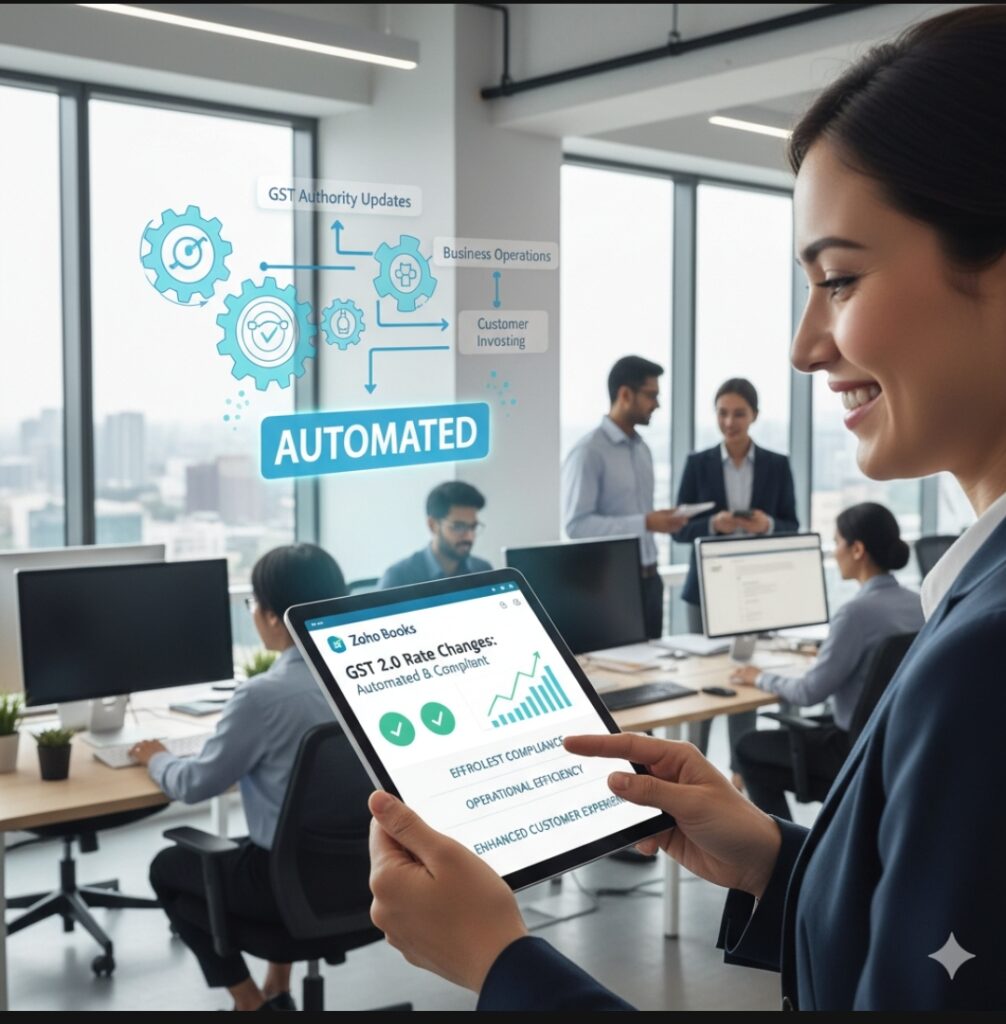Zoho Books Simplifies GST 2.0 Compliance: How Automated Tax Management Transforms Business Operations
The recent announcement by Zoho regarding its GST-compliant accounting software’s readiness for the GST 2.0 rate changes represents more than just a technical update. Furthermore, it exemplifies how modern business automation can transform customer experience while ensuring seamless regulatory compliance. As businesses across India prepare for the major tax reform effective September 22, 2025, this development offers valuable insights into the evolving relationship between technology, compliance, and customer satisfaction.
Understanding GST 2.0: A Simplified Tax Revolution
India’s GST Council has implemented the most significant overhaul of the tax system since GST’s introduction in 2017. Subsequently, the new GST 2.0 framework simplifies the previous four-tier structure (5%, 12%, 18%, 28%) into a more streamlined three-tier system. Therefore, businesses now operate under merit rates of 5% for essentials, standard rates of 18% for most goods and services, and luxury rates of 40% for premium items.
This transformation aims to reduce compliance complexity while boosting domestic consumption. Moreover, the government expects this change to cushion India’s economy against external pressures, particularly potential US tariffs on Indian goods. Consequently, businesses must adapt quickly to these new rate structures to maintain competitive advantages.
The reform represents a fundamental shift in how businesses approach tax calculations and compliance. Additionally, it eliminates the confusion surrounding classification disputes that previously plagued businesses. Therefore, companies can now focus more resources on growth initiatives rather than navigating complex tax regulations.
The Customer Experience Challenge in Tax Compliance
Traditional GST compliance presents numerous customer experience challenges that extend far beyond simple calculations. Initially, businesses struggle with multiple return filings, including GSTR-1, GSTR-3B, and various quarterly submissions. Furthermore, these processes often require significant manual intervention, creating bottlenecks that impact overall business operations.
Research indicates that over 70% of businesses struggle with GST return filing due to various factors. Specifically, these challenges include lack of awareness about regulatory changes, frequent data entry errors, inadequate technology infrastructure, and time management issues. Additionally, complex filing procedures create significant operational burdens, particularly for small and medium enterprises.
The customer experience implications extend beyond internal operations. Subsequently, businesses experiencing compliance difficulties often pass these challenges onto their customers through delayed deliveries, pricing inconsistencies, or service interruptions. Therefore, automated tax management becomes crucial for maintaining smooth customer interactions.
Manual tax processes also introduce significant risk factors that can damage customer relationships. Moreover, human errors in calculations can lead to overcharging customers or creating pricing discrepancies across different sales channels. Consequently, businesses need reliable automation solutions to ensure consistent, accurate pricing for all customer interactions.
Automated Tax Management: Transforming Business Operations
Modern tax automation solutions offer transformative benefits that directly impact customer experience metrics. Primarily, these systems eliminate human errors in data entry and calculations by applying the latest tax rules consistently and accurately. Additionally, automated solutions save significant time by handling routine tasks such as data collection, calculations, and form filling.
The efficiency gains from tax automation are substantial. Specifically, businesses report improved first contact resolution rates, higher volumes of processed requests, and enhanced accuracy in customer transactions. Furthermore, automated systems provide immediate responses to pricing inquiries and ensure consistent handling of customer interactions.
Cost reduction represents another significant advantage of automation. Initially, tax preparation automation requires investment, but it creates long-term savings by reducing manual labor and external tax preparation fees. Moreover, automated systems accommodate business growth without requiring proportional increases in compliance staff.
Tax automation also provides valuable financial insights that enhance customer service capabilities. Subsequently, these systems often include analytics features that give businesses insight into financial health, tax liabilities, and savings opportunities. Therefore, companies can make more informed pricing decisions that benefit both business profitability and customer satisfaction.
Zoho Books: Setting the Standard for Automated Compliance
Zoho Books exemplifies how modern accounting software can transform the customer experience through intelligent automation. Specifically, the platform handles GST calculations automatically, applies appropriate tax rates for different transactions, and generates compliant invoices seamlessly. Additionally, it automates the creation, management, and submission of invoices while ensuring accurate tax calculations.
The software’s approach to customer experience automation reflects broader industry trends. Moreover, Zoho Books eliminates the need for businesses to manually track regulatory changes, as the system automatically updates tax rates and applies them to transactions. Consequently, businesses can focus on serving customers rather than managing compliance complexities.
Sivaramakrishnan Iswaran, Global Head of Finance and Operations BU at Zoho, emphasizes the strategic importance of automated compliance: “With the GST 2.0 rate changes taking effect, Zoho Books customers can rest assured that the applicable tax rates are updated automatically in the system, reducing manual effort and minimising the risk of misclassification.” Furthermore, this approach ensures that compliance becomes invisible to both businesses and their customers.
The platform’s comprehensive features demonstrate how automation can enhance every aspect of the customer experience. Additionally, Zoho Books offers multi-user access, payment gateway integration, customer management capabilities, and cloud-based data accessibility. Therefore, businesses can provide consistent service across all customer touchpoints while maintaining perfect compliance.
The Strategic Impact of Seamless Compliance
The broader implications of automated tax management extend far beyond simple compliance. Initially, businesses using automated systems report significant improvements in customer satisfaction metrics. Specifically, faster response times, personalized communications, and 24/7 support capabilities create better overall customer experiences.
Research from ActiveCampaign demonstrates the quantifiable impact of customer experience automation, with B2B businesses reporting customer lead increases of 110%, deal win rates increasing by 92%, and sales effectiveness improving by 109%. Moreover, these improvements directly correlate with automated processes that eliminate friction in customer interactions.
The customer experience benefits become particularly evident during periods of regulatory change. Subsequently, businesses with automated systems can implement new tax rates immediately without disrupting customer service operations. Therefore, customers continue receiving consistent service while competitors struggle with manual compliance updates.
Data-driven insights represent another crucial advantage of automated compliance systems. Additionally, these platforms capture and analyze vast amounts of customer interaction data, providing valuable insights into customer behavior and preferences. Consequently, businesses can make more informed decisions about pricing strategies and service improvements.

Looking Forward: The Future of Compliance and Customer Experience
As GST 2.0 implementation demonstrates, the future of business operations increasingly depends on seamless integration between compliance requirements and customer experience delivery. Furthermore, companies that successfully automate these processes gain significant competitive advantages through improved operational efficiency and enhanced customer satisfaction.
The transformation extends beyond simple cost savings or compliance efficiency. Moreover, automated systems enable businesses to allocate human resources to higher-value activities that directly impact customer relationships. Therefore, companies can invest more in customer service innovation while ensuring perfect regulatory compliance.
Technology continues evolving to make compliance increasingly invisible to end customers. Subsequently, future developments in artificial intelligence and machine learning will further enhance the predictive capabilities of tax automation systems. Additionally, these improvements will enable even more sophisticated personalization of customer experiences while maintaining perfect compliance standards.
The GST 2.0 transition represents a pivotal moment for Indian businesses to embrace comprehensive automation strategies. Furthermore, companies that successfully implement these systems now will be better positioned to handle future regulatory changes while continuously improving their customer experience capabilities. Therefore, the investment in automated compliance technology becomes not just a necessity but a strategic advantage in an increasingly competitive marketplace.


